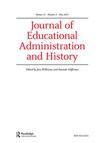信任数字:1963-1972年丹麦小学治理
IF 1.8
Q2 EDUCATION & EDUCATIONAL RESEARCH
Journal of Educational Administration and History
Pub Date : 2021-12-06
DOI:10.1080/00220620.2021.1997946
引用次数: 0
摘要
本文旨在为有关IT系统中的数字数据过去和现在用于管理小学教育发展的方式的文献做出贡献,因为数据为政府提供了以新的方式“看到”教育系统的机会。第二次世界大战后西方世界的经济增长与教育息息相关。具有数字数据的基于信息技术的新技术形式有助于规划,因为人们对数字数据作为客观现象有很大的信心。本文展示了丹麦教育部如何在20世纪60年代和70年代建立了许多IT系统。系统内的数据为教育部提供了一个机会,以一种新的方式“看到”教育系统,从而改变系统。在更广泛的范围内,本文有助于目前关于如何使用数字数据来管理公民的辩论。本文章由计算机程序翻译,如有差异,请以英文原文为准。
Trust In numbers: Danish Primary School Governance 1963–1972
ABSTRACT This paper aims to contribute to the literature relating to the way in which numerical data in IT systems were and are used to govern the development of primary education as data provide the government with the opportunity to ‘see' the system of education in a new way. Economic growth in the Western world after World War II was linked to education. New IT-based forms of technology with numerical data could help planning as there was great confidence in numerical data as objective phenomena. The article shows how the Danish Ministry of Education established a number of IT systems during the 1960s and 1970s. Data within the systems provided the Ministry with an opportunity to ‘see’ the system of education in a new way and thereby change the system. On a wider scale, this article contributes to the present debate on how numerical data is used to govern citizens.
求助全文
通过发布文献求助,成功后即可免费获取论文全文。
去求助
来源期刊

Journal of Educational Administration and History
EDUCATION & EDUCATIONAL RESEARCH-
CiteScore
3.80
自引率
5.60%
发文量
25
 求助内容:
求助内容: 应助结果提醒方式:
应助结果提醒方式:


